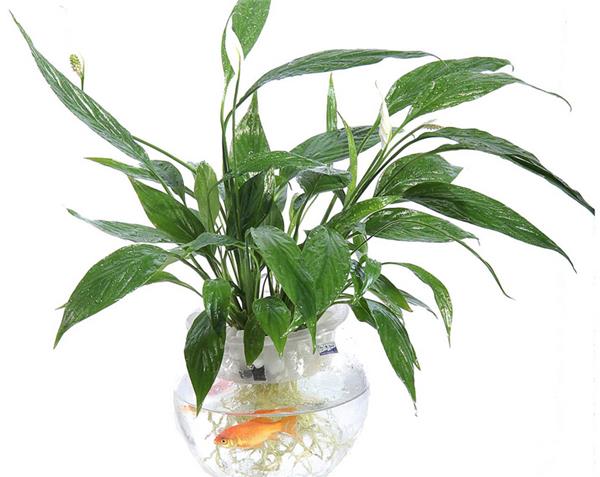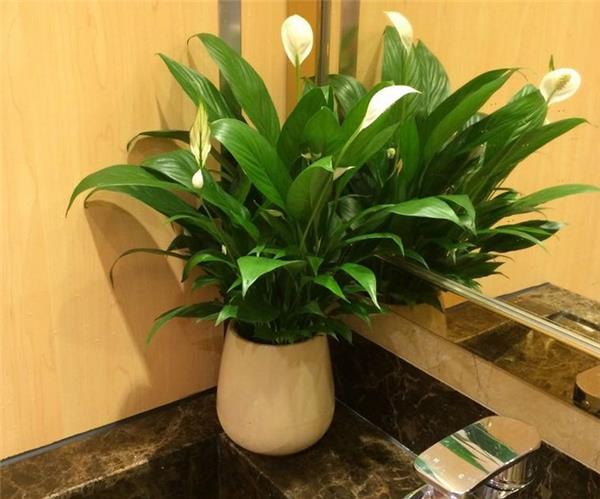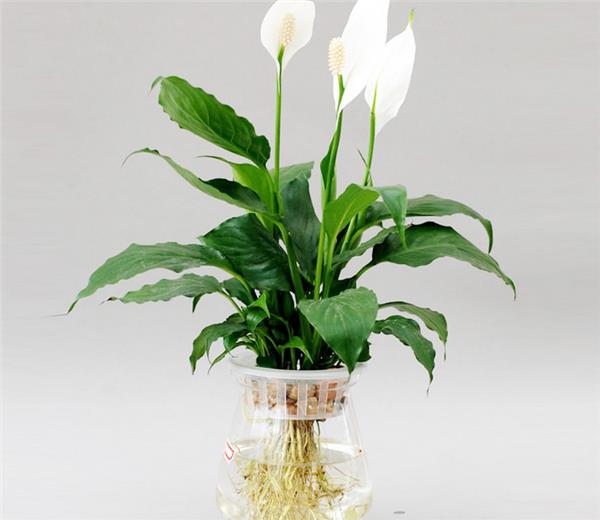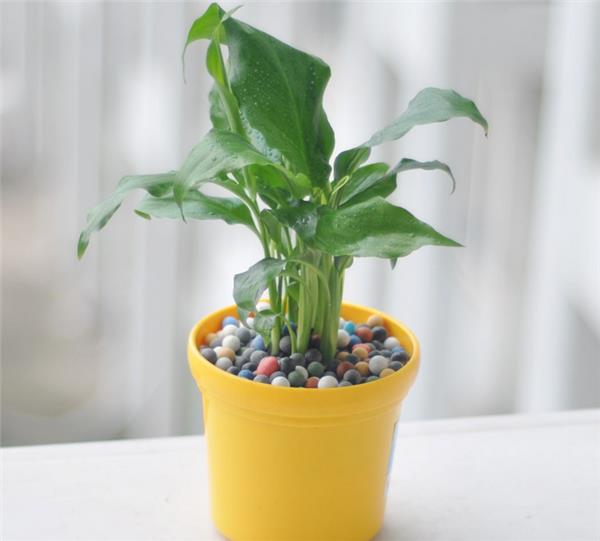Smooth farming methods and matters needing attention
Do you know? Plain sailing not only represents good wishes, but also exists in the form of a plant. Now we will share with you the next smooth sailing breeding methods and points for attention.

A brief introduction to plain sailing
Plain sailing, also known as White Crane Taro, alias: White palm, bract taro, is a perennial herb, native to tropical America, like high temperature, humid and semi-shady environment. Plain sailing green leaves, white Buddha bud, very fresh and elegant, is an important ornamental flower in the world. It is also an expert at filtering indoor waste gas and has a certain effect on ammonia, acetone, benzene and formaldehyde. It has been used in potted plants since the beginning of the 20th century.
Smooth sailing leaves long elliptic-lanceolate, acuminate at both ends, veins obvious, petiole long, base sheathlike; scape erect, higher than foliage, spawn erect, slightly curled, white; fleshy inflorescences cylindrical, white.

A smooth farming method
1. Reproduction
Ramet propagation: it is best to carry out the propagation from May to June; lift the whole plant out of the pot and cut the rhizome from the base of the plant clump, with at least 3-4 leaves in each clump, and restore it in semi-shade after planting.
Sowing and reproduction: seeds can be obtained by artificial pollination after flowering. The seeds should be sowed immediately after seed collection, the germination temperature is 30 ℃, and germinate 10-15 days after sowing.
Tissue culture propagation: young inflorescences and lateral buds were used as explants and inoculated on MS medium supplemented with 10 mg / L 6-benzylaminoadenine and 2 mg / L indole acetic acid after disinfection. Callus and adventitious buds grew after 40 days. Then the adventitious buds were transferred to MS medium supplemented with indole acetic acid 2 mg / L, and rooting was induced in about 30 to 40 days.
2. Lighting
Plain sailing is more shady, so it is suitable to grow in a semi-overcast environment, avoid direct sunlight. According to the experiment, about 60% of the scattered light can meet the needs of smooth sailing growth, so it can be cultured indoors with bright scattered light all the year round. If it is exposed to strong light, it will cause the leaves to turn yellow and even directly sunburn. Greenhouse cultivation in northern winter can not shade or less shade, if the long-term light is too dark, then smooth sailing is not easy to bloom.
3. Temperature
Plain sailing likes high temperature, especially afraid of cold, the most suitable growth temperature is 20 Mel 28 ℃, once it is put indoors in winter, the lowest temperature it can withstand is 10 degrees, so you should pay attention to it in winter, so relatively speaking, the farming conditions in the north are too poor, and plain sailing will cause root rot, leaf shedding or scorched yellow, and serious ones may even lead to death.
4. Soil
Soil is the basis of aquaculture. Pot planting requires loose soil, good drainage and ventilation, and can not use clayey soil. Generally, rotten leaf soil, peat soil and a small amount of perlite can be used as substrate, and a small amount of organic fertilizer can be added as base fertilizer when planting.

5. Watering
Plain sailing has a high demand for water, and the wettability of the basin soil must be kept constantly. But can not accumulate water, once too much watering, a large amount of water accumulated in the basin, it is easy to cause rotten roots and plants withered and yellow. In summer and drought, we should often spray water to the leaves and the ground to increase air humidity, so as to be conducive to its growth. Watering should be controlled in winter, and the basin soil should be slightly wet.
6. Fertilization
Due to the smooth growth rate and large amount of fertilizer, liquid fertilizer should be applied every 1-2 weeks in the growing season. Fertilizer should be applied thinly, do not apply thick fertilizer or raw fertilizer, and water once after applying solid fertilizer, it is best to use thin fertilizer instead of clear water, so that it generally does not produce fertilizer damage, and the plant grows luxuriantly.
7. Diseases and insect pests
This is a common problem of domestic plants, as long as proper care can be avoided. If harmful mites are harmful, the leaves show bad symptoms such as wilting, gloss desalination, yellow blight and so on, which can be controlled by spraying special mites, such as triclofenac, Nisolan, pyridaben and so on.

Matters needing attention in smooth sailing culture
1. White crane taro needs high growth humidity, and the leaves will wilt if the air is too dry.
2. To master the appropriate level of light, generally speaking, the degree of shade needed for planting white crane taro is at least 73%. In summer, 80% of the shade degree will be better. If the light level is too low, the color of white crane taro leaves will become lighter and the growth will be hindered.
3. White crane taro is easy to grow, but the demand for magnesium is much higher than that of many other foliage plants. When magnesium supply is insufficient, the edge of the old leaves of white crane taro will turn yellow.
4. It is critical to control root rot; if the plant is infected with root rot, the root system will blacken and lead to the withering and withering of the old leaves, and in serious cases, it will lead to plant death.
5. Spraying gibberellic acid to induce plant flowering artificially, the flowering time of different varieties is also different, it should be noted that too high concentration of gibberellic acid will cause plant flower deformation.
6. Choose the appropriate size container according to the variety.
But the demand for magnesium is much higher than that of many other foliage plants, and when magnesium is in short supply, the edges of the old leaves of taro turn yellow.
4. It is critical to control root rot; if the plant is infected with root rot, the root system will blacken and lead to the withering and withering of the old leaves, and in serious cases, it will lead to plant death.
5. Spraying gibberellic acid to induce plant flowering artificially, the flowering time of different varieties is also different, it should be noted that too high concentration of gibberellic acid will cause plant flower deformation.
6. Choose the appropriate size container according to the variety.
Related
- Wuhan Hospital Iron Tree Blooming Result Was Instantly Frightened by the Gardener Master
- Which variety of camellia is the most fragrant and best? Which one do you like best?
- What is the small blue coat, the breeding methods and matters needing attention of the succulent plant
- Dormancy time and maintenance management of succulent plants during dormancy
- Minas succulent how to raise, Minas succulent plant pictures
- What are the varieties of winter succulent plants
- How to raise succulent plants in twelve rolls? let's take a look at some experience of breeding twelve rolls.
- Attention should be paid to water control for succulent plants during dormant period (winter and summer)
- Watering experience of twelve rolls of succulent plants
- Techniques for fertilizing succulent plants. An article will let you know how to fertilize succulent plants.



